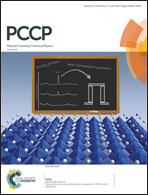Effects of the asphaltene structure and the tetralin/heptane solvent ratio on the size and shape of asphaltene aggregates
Abstract
Asphaltene molecules, which consist of differently hydrogenated polyaromatic cores grafted with side alkyl chains of different sizes and grafting densities, were simulated with a solvent mixture of heptane and tetralin using coarse-grained force fields. Starting with the initial configuration of randomly distributed asphaltene molecules and solvents, the asphaltene molecules aggregate because of the attractive force between their polyaromatic cores, but their sizes and shapes differ. The average aggregate size decreases with an increase in the hydrogenated polycyclic core, side-chain length, and tetralin concentration, which agree with experimental observations in the hydrocracking process. The number of side chains also influences the aggregate size but only in the presence of tetralin. In particular, the effect of tetralin addition occurs more significantly for asphaltene molecules with more side chains because side chains sterically block the intermolecular interactions between polyaromatic cores, which makes it easier for the aromatic ring of tetralin to bind to the polyaromatic core of asphaltene. These steric effects of side chains yield different shapes of aggregates, showing parallel stacking (face-to-face) for aromatic cores with many side chains, and T-shape (edge-to-face) or offset-parallel stacking for those with fewer side chains. These findings agree with the experimental observation regarding the effect of tetralin on the solubility of asphaltene, and indicate that the extent of the tetralin effect depends on the number of side alkyl chains, implying that tetralin solvents need to be added with consideration for the structural change of asphaltene under hydrogenation or dealkylation conditions.



 Please wait while we load your content...
Please wait while we load your content...